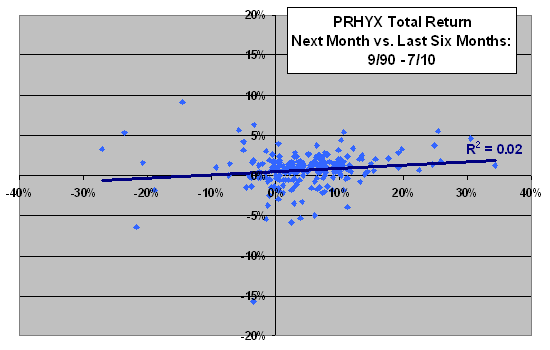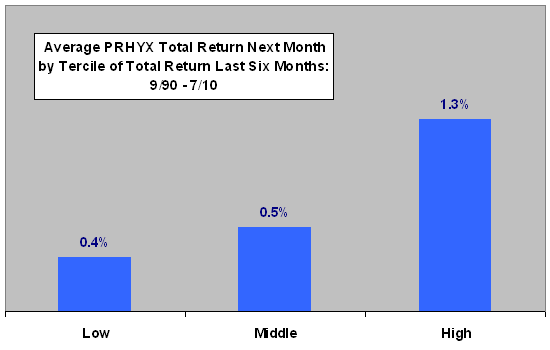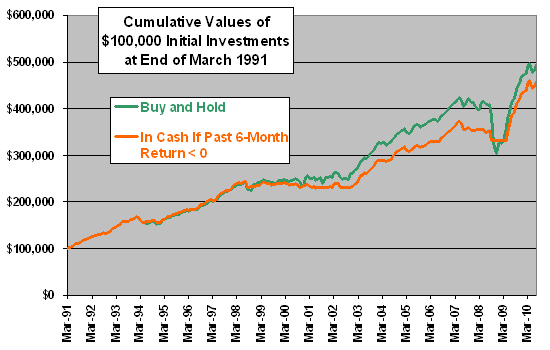A reader commented and suggested: “Because bond trading costs would probably dwarf the excess profits described in ‘Momentum in U.S. Corporate Bond Returns’ for individual investors, perhaps the relevant question is whether switching from one junk bond fund to another based on 6-month momentum (with one skip-month) is effective.” Since the momentum in this case belongs to an asset class (junk bonds) rather than to specific bonds within it, a more useful investigation might be whether one should get in and out of junk bond funds based on momentum. Using monthly dividend-adjusted closes for the T. Rowe Price High-Yield mutual fund (PRHYX) and the 13-week Treasury bill (T-bill) yield (a proxy for return on cash) during September 1990 through July 2010 (239 months), we find that:
The following scatter plot relates PRHYX total return next month to PRHYX total return over the last six months over the entire sample period. The Pearson correlation for the relationship is 0.14, and the R-squared statistic is 0.02, indicating that past return explains 2% of the next-month return. Inserting a skip-month reduces the correlation to 0.03 and R-squared to 0.00 over the entire sample period, suggesting that use of a skip-month is not helpful.
Note that a sample of only 40 non-overlapping six-month return intervals, with some intervals of extreme variability in monthly returns (especially late 2008 through early 2009, does not promise reliability. For example:
- Excluding the single monthly return of April 2009 (paired with the past return for September 2008 through March 2009) increases R-squared to 0.04.
- Over the first half of the sample period (ending October 2000), the correlation is 0.20 and R-squared is 0.04. Over the second half, the correlation is 0.12 and R-squared is 0.01.
For another perspective that accommodates non-linearity, we try a ranking approach.

The next chart summarizes PRHYX average total return next month by tercile of PRHYX returns for the past six months over the entire sample period (no skip-month). The number of observations in each tercile is 77-78. Results offer support for a belief that return momentum exists for an investable collection of junk bonds.
The standard deviation of monthly returns within the lowest tercile is much higher than those within the other two.
Could a trader have beaten buying and holding the fund by using momentum measurements to switch between the fund and cash?

The final chart compares cumulative values of $100,000 investments initiated at the end of March 1991 for two strategies:
- Buying and holding PRHYX.
- Holding PRHYX (cash, with a return equal to that of T-bills) when the fund’s total return over the past six months is positive (negative). The 0% past return threshold is arbitrary.
Calculations assume trades occur at month ends, coincident with momentum measurements. Such anticipation is somewhat problematic with mutual funds, priced only daily after the close. Calculations also assume no trading frictions or tax implications.
Results suggest that switching between the fund and cash roughly matches or slightly underperforms buying and holding the fund. For past return thresholds in the range of 3-5%, switching between the fund and cash marginally beats buying and holding the fund. An investor operating in real time would not know the optimum threshold (but might choose a threshold based on the historical risk-free rate rather than 0%).
Overall, results suggest that junk bond mutual fund momentum may not support outperformance when the only asset choices are the fund and cash. However, junk bond fund momentum may support multi-asset class allocation strategies such as those described in “A Few Notes on The Ivy Portfolio”, “The Decision Moose Asset Allocation Framework” and “An Investor’s Asset Class Momentum Trading Strategy”.

In summary, evidence from simple tests suggest that junk bond mutual funds exhibit return momentum perhaps exploitable via a multi-asset class allocation strategy (but not a standalone timing strategy).